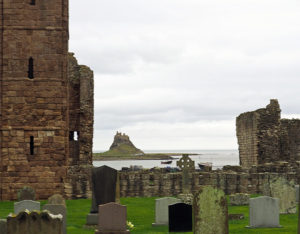This is perhaps on of the most important sites in early Christianity with its links to St Aidan and St Cuthbert.
Holy Island is located just off the coast of Northumberland overlooking a natural harbour. In 634AD Oswald, King of Northumbria granted the island to the church and a monastic community led by St Aidan with monks from Iona established a monastery here which played a key part in the spread of Christianity across northern England. There were two small wooden churches with domestic and service accommodation, surrounded by a ditch and bank.
Aidan was succeeded by Cuthbert in 670AD and the monastery rapidly became a centre of Christian learning. The Lindisfarne Gospels were written here in early 700s. At its peak, there were probably about 30 monks here along with novices and lay people. After Cuthbert’s death, his body was enshrined before the high altar and Lindisfarne became an important pilgrimage centre. The growing wealth of the monastery made it a target for Viking raids. The last Danish raid in 875 led to its abandonment when the monks left, taking St Cuthbert’s body and other precious relicts, including the Lindisfarne Gospels, with them. A small Christian community seems to have survived on Lindisfarne as fragments of C8-C10th Carved crosses have been found and are on display in the museum.
After the Norman invasion, Lindisfarne Priory was re-founded in 1070, by a group of Benedictine monks from Durham Cathedral. Work began on a splendid stone church in 1120 using locally quarried stone, over the spot they believed St Cuthbert had been buried, with a cenotaph marking the spot. The original church had a small chancel apse but this was later extended to form a rectangular chancel. Once the Priory Church was completed, work began on the monastic buildings, with a courtyard with the domestic buildings to the south of the church and the Prior’s House in the south east corner. Monks from Durham served here on rotation. At its height in the late 1200s Lindisfarne Priory was home to perhaps 10 monks, a prior and supported by a large number of servants.
Lindisfarne was never a wealthy monastery. C14th border raids on the local area from Scotland led to a drop in tithes and land rents from estates on the mainland. The number of monks fell to four.
The monastery was fortified by building a defensive wall and tower, forming an outer and inner courtyard. Battlements were built round the top of the church and towers and arrow slits added. Extra protection was provided by a barbican on the gateway between inner and outer courtyard. The outer courtyard served a similar function to the outer bailey of a traditional castle.
After the Dissolution of the Monasteries by Henry VIII in 1534, the priory and its estates passed into the possession of the crown. The island was taken into Crown ownership. The buildings were used as storehouses for the fort (now the site of the Castle) built to protect the harbour. They finally fell into disuse in the C17th when the lead was stripped from the church roof and the central tower collapsed, leaving the iconic rainbow arch, one of the ribs of the vaulted ceiling. Villagers used the stone for building stone. By the late C18th the ruins were becoming a popular attraction for both artists and antiquarians. The west front collapsed in the 1850s and was carefully reconstructed at the crown’s expense. The site has been in the care of English Heritage since 1984 and is one of the most visited sites in the country.
Opening times can be found “here,”:https://www.english-heritage.org.uk/visit/places/lindisfarne-priory/prices-and-opening-times/ although the Priory can be shut at short notice for staffing problems. It is however, possible to see most of the ruins over the wall or by climbing up to the lookout tower on the hill overlooking them.
The museum is in the Visitor centre which has a collection of Anglo Saxon stonework and crosses and other artefacts from the site.
DISABLED ACCESS
Although there is level access to the museum building, disabled access to the ruins themselves is not good. There are five steps down into the priory ruins. This is built on a slight slope, with grass and gravel paths.
it is possible to drive close to the site to drop off passengers with reduced mobility but the only disabled parking is in the village car park, about 400 yds away. There is a wheelchair available from the museum. There are no accessible toilets on the site.
“Website”:https://www.english-heritage.org.uk/visit/places/lindisfarne-priory/
There are lots more pictures “here.”:http://wasleys.org.uk/eleanor/churches/england/ruined_abbeys/north/lindisfarne/index.html








